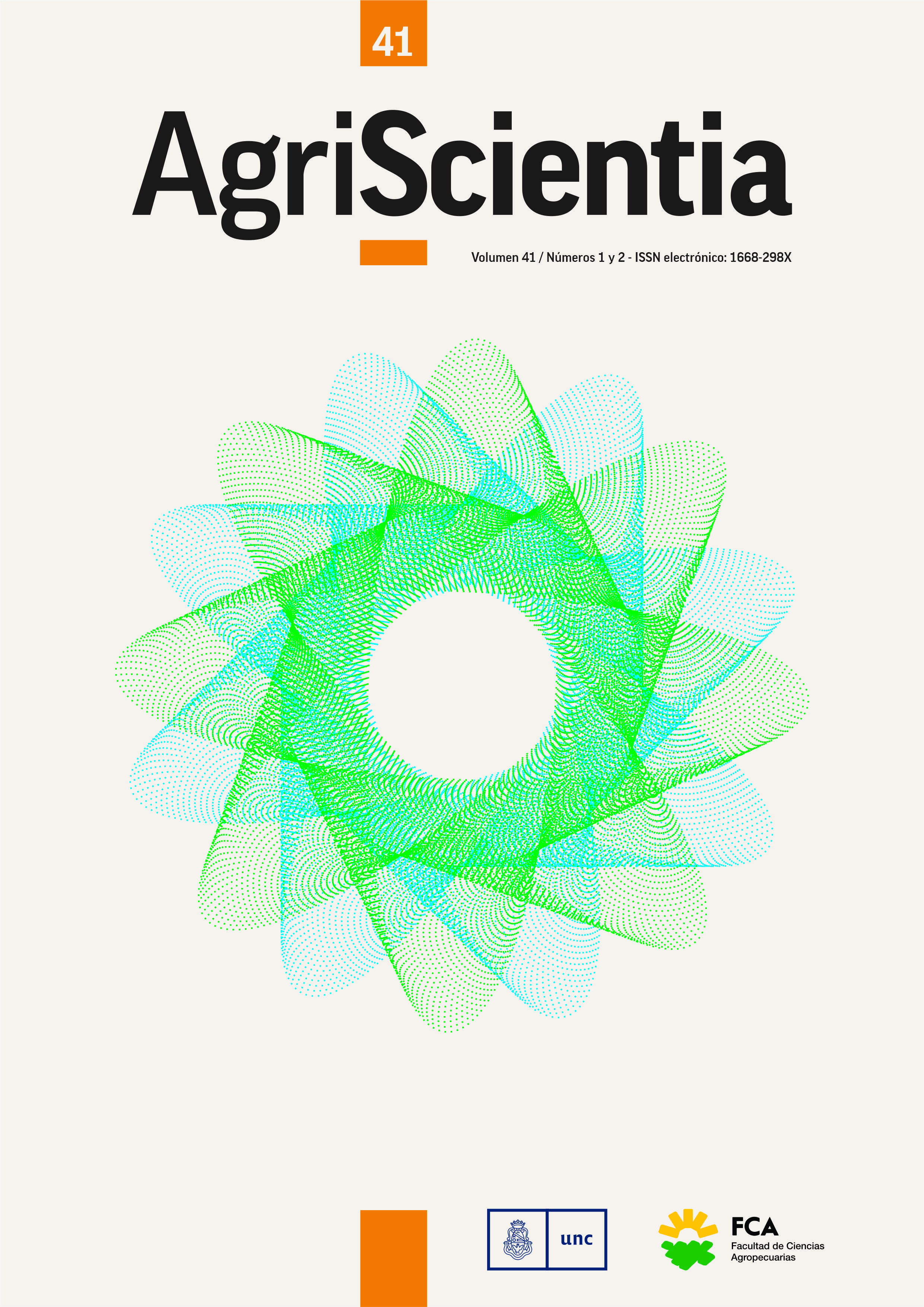(2024). Contri- butions to the morphology of Hibiscus cannabinus L. seeds and ad- justment of the tetrazolium test to estimate viability and vigor
Main Article Content
Abstract
Hibiscus cannabinus L. is an annual species cultivated for its fibers. The morphological description of the seeds of the cultivars ‘Endora’ and ‘Tainung' 1’ was broadened, a tetrazolium test procedure was adapted and adjusted, and the embryos were classified according to their viability and vigor. Cells from the seed coat layers participate in the seed coloration and ornamentation. The imbibition cap and the isthmus were identified, and their function was
analyzed. Lipids and proteins were recognized in the mesophyll of cotyledons and the absence of areoles in the epidermis. Using the tetrazolium test, staining patterns were established to classify the seeds according to their viability. Both cultivars presented acceptable viability values. The germination test supported the proposed methodology for tetrazolium. Novel contributions are made to seed morphology, and structure-function relationships for water intake are proposed. The seeds of both cultivars share the morphological characteristics that are fundamental to the establishment of evaluation criteria in the tetrazolium biochemical test. The adapted tetrazolium viability test protocol allowed the seeds classification as either viable into three categories (high, medium, and low vigor) and non-viable seeds.
Downloads
Article Details

This work is licensed under a Creative Commons Attribution-ShareAlike 4.0 International License.
References
Abid, R., Ather, A. y Qaiser, M. (2016). Seed morphology and its taxonomic significance in the family Malvaceae. Pakistan Journal of Botany, 48, 2307-2341.
Acreche, M., Gray, L.N., Collavino, N. y Mariotti, J. (2005). Effect of row spacing and lineal sowing density of kenaf (Hibiscus cannabinus L.) yield components in the North-West of Argentina. Spanish Journal of Agricultural Research, 3(1), 123-129. https://doi.org/10.5424/sjar/2005031-132 DOI: https://doi.org/10.5424/sjar/2005031-132
Association of Official Seed Analysts (AOSA, 2010). AOSA/ SCST. Tetrazolium Testing Handbook. Association of Official Seed Analysts.
Barthlott, W. (1981). Epidermal and seed surface characters of plants: systematic applicability and some evolutionary aspects. Nordic Journal of Botany, 1(3), 345-355. https://doi.org/10.1111/j.1756-1051.1981.tb00704.x DOI: https://doi.org/10.1111/j.1756-1051.1981.tb00704.x
Baskin, J.M. y Baskin, C.C. (2014). Seeds Ecology, Biogeography, and Evolution of Dormancy and Germination (2 ed). Academic Press.
Boesewinkel, F.D. y Bouman, F. (1984). The seed: structure. En: B.M. Johri (Ed.), Embryology of Angiosperms (567-610). Springer. DOI: https://doi.org/10.1007/978-3-642-69302-1_12
Bornand, A.V. y Beltramini, V.S. (2021). Caracterización morfológica de la semilla de Hibiscus cannabinus (Malvaceae) e influencia del tiempo de almacenamiento sobre la viabilidad. Lilloa, 58(1), 51-62. https://doi.org/10.30550/j.lil/2021.58.1/2021.04.26 DOI: https://doi.org/10.30550/j.lil/2021.58.1/2021.04.26
Corner, E. J.H. (2009). The Seeds of Dicotyledons. Cambridge University Press.
Delouche, J.C., Still, T.W., Raspet, M. y Lienhard, M. (1962). The tetrazolium test for seed viability. (Boletín Técnico 51). Mississippi, EEUU: Mississipi State University.
Di Rienzo, J.A., Casanoves, F., Balzarini, M.G., González, L., Tablada, M. y Robledo, C.W. (versión 2021). [Software]. Córdoba, Argentina: Centro de Transferencia Infostat, Facultad de Ciencias Agropecuarias, Universidad Nacional de Córdoba.
Endo, Y. y Ohashi, H. (1998). The features of cotyledon areoles in Leguminosae and their systematic utility. American Journal of Botany, 85, 753-759. https://doi.org/10.2307/2446409 DOI: https://doi.org/10.2307/2446409
Evert, R.F. (2008). Esau Anatomía vegetal. Meristemas, células y tejidos de las plantas: su estructura, función y desarrollo (3a ed.). Omega.
Falasca, S.L., Ulberich, A.C. y Pitta-Alvarez, S. (2014). Possibilities for growing kenaf (Hibiscus cannabinus L.) in Argentina as biomass feedstock under dry- subhumid and semiarid climate conditions. Biomass and bioenergy, 64, 70-80. https://doi.org/10.1016/j.biombioe.2014.03.031 DOI: https://doi.org/10.1016/j.biombioe.2014.03.031
França-Neto, J.B., Pereira, L.A.G., Costa, N.P., Krzyzanowski, F.C. y Henning, A.A. (1988). Metodología do teste de tetrazólio em sementes de soja. Londrina: EMBRAPA-CNPSo. Font Quer, P. (2001). Diccionario de Botánica (2a ed.). Península.
Hayward, H. (1953). Estructura De Las Plantas Útiles. ACME, S.A. Instituto Nacional de Estadísticas y Censos (INDEC, 2021). Censo Nacional Agropecuarios 2018, Resultados definitivos. Ciudad Autónoma de Buenos Aires. https://www.indec.gob.ar/ftp/cuadros/economia/cna2018_resultados_definitivos.pdf
International Seed Testing Association. (ISTA, 2003). Working Sheets on Tetrazolium Testing. (Volumen 1). International Seed Testing Association.
International Seed Testing Association. (ISTA, 2018). Handbook on Seedling Evaluation (4a ed.) International Seed Testing Association.
International Seed Testing Association. (ISTA, 2021). International Rules for Seed Testing. International Seed Testing Association.
Kirkbride, J.H. Jr., Gunn, C.R. y Weitzman, A.L. (2003). Fruits and seeds of genera in the subfamily Faboideae (Fabaceae). (Boletín técnico del Departamento de Agricultura de los Estados Unidos, N.o 1890). Agricultural Research Service.
Martin, A.C. (1946). The comparative internal morphology of seeds. The American Midland Naturalist, 36, 513-660. DOI: https://doi.org/10.2307/2421457
McCarty, W.H. y Baskin, C.C. (1978). Cotton Seed Quality Evaluation. Seed Technology Papers, 29. Retrieved from https://scholarsjunction.msstate.edu/seedtechpapers/29
Ministerio de Agricultura, Ganadería y Abastecimiento de Brasil. Secretaría de Defensa Agropecuaria (2009). Regras de Análise de Sementes. Assessoria de Comunicação Social. Recuperado de: https://www.gov.br/agricultura/pt-br/assuntos/insumos-agropecuarios/arquivos-publicacoes-insumos/2946_regras_analise__sementes.pdf
Monti, A. y Alexopoulou, E. (2013). Kenaf: a multipurpose crop for several industrial applications. Springer Verlag. https://doi.org/10.1007/978-1-4471-5067-1 DOI: https://doi.org/10.1007/978-1-4471-5067-1
Moore, R.P. (1962). TZ checks your seed for quality. Crops and Soils, 15, 10-12. Moore, R.P. (1985). Handbook on tetrazolium testing. International Seed Testing Association.
Moreira de Carvalho, N. y Nakagawa, J. (1988). Semillas: ciencia, tecnología y producción. Agropecuaria Hemisferio Sur.
Müssig, J. (Ed.) (2010). Industrial Applications of Natural Fibres Structure, Properties and Technical Applications. Wiley and Sons. DOI: https://doi.org/10.1002/9780470660324
Olteanu, R. (1933). Etude monographique sur Hibiscus esculentus (Abelmoschus esculentus (L.) MEY.). Laupen-Berne: Société polygraphique.
Pascualides, A.L., Baigorria, M.C., Rinaldi, G.V., Buffa Menghi, M.N. y Bornand, A.V. (2013). Evaluación de dos fechas de siembra de Hibiscus cannabinus L. “kenaf” (Malvaceae) en Villa del Totoral, Córdoba, Argentina. Agronomía & Ambiente, 33(1-2), 31-42.
Perissé, P. y Tourn, G.M. (2015). Morfología de la semilla, presencia de aréolas y entrada de agua en la imbibición de Vicia dasycarpa Ten. cv. Tolse F.C.A. Phyton, 84(1), 184-189. RAL. (2024). Colores RAL CLASSIC. https://cartaral.es/pages/colores-ral DOI: https://doi.org/10.32604/phyton.2015.84.184
Werker, E. (1997). Seed Anatomy. Gebrüder Borntraeger. Winter, D. (1960). The development of the seed of Abutilon theophrasti. II Seed coat. American journal of botany, 47(3), 157-162. https://doi.org/10.1002/j.1537-2197.1960.tb07108.x DOI: https://doi.org/10.1002/j.1537-2197.1960.tb07108.x
Zarlavsky, G.E. (2014). Histología Vegetal: Técnicas simples y complejas. Sociedad Argentina de Botánica.





